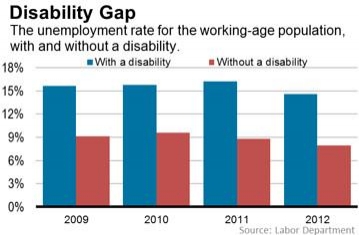By Jeffrey Sparshott
http://ht.ly/lYv8N (ขนาดไฟล์: 0 )
An improving economy is helping lower the unemployment rate for people with disabilities, though the job market remains tough for the deaf, blind and others with physical or mental conditions.
The unemployment rate for people with disabilities fell to 13.4% last year from 15.0% in 2011, the Labor Department said in a report released Wednesday. By comparison, the unemployment rate for people without a disability was 7.9% in 2012, down from 8.7% a year earlier.
The lower rate comes as the number of persons with disabilities who have a job increased to a little more than 5 million.
But the unemployment rate only captures those who were available and actively looking for work. About 8 in 10 persons with disabilities weren’t in the labor force in 2012, compared with about 3 in 10 persons with no disability, the Labor Department said.
The disparity in part reflects demographics. Nearly half of persons with a disability were 65 years or older. Older people are more likely to be retirees than frustrated job seekers.
But strip out the elderly and the unemployment rate for people with disabilities is even higher at 14.6% for people of working age, versus 7.9% for those with no disability.
“The unemployment rate remains abysmally high,” said Mark Perriello, president and chief executive of the American Association of People with Disabilities.
Mr. Perriello said people with disabilities face an array of obstacles, notably “a lack of understanding about our capacity to perform daily tasks and contribute to the workforce. And that will take a long time to change.”
One interesting note from the report: persons with a disability are more likely to be self-employed — a little more than 11%, versus 6.5% of persons with no disability work in their own business, trade or farm.
“I actually think they are continuing a long tradition that other marginalized communities have started,” Mr. Perriello said. “If no one will hire you, start a business for yourself. Don’t let barriers get in the way.”
ที่มา: http://ht.ly/lYv8N (ขนาดไฟล์: 0
)
วันที่โพสต์: 17/06/2556 เวลา 04:30:34 
![]()
![]()
แสดงความคิดเห็น
รายละเอียดกระทู้
Disability Gap the unemployment rate for the working-age population, with and without a disability. http://ht.ly/lYv8N An improving economy is helping lower the unemployment rate for people with disabilities, though the job market remains tough for the deaf, blind and others with physical or mental conditions. The unemployment rate for people with disabilities fell to 13.4% last year from 15.0% in 2011, the Labor Department said in a report released Wednesday. By comparison, the unemployment rate for people without a disability was 7.9% in 2012, down from 8.7% a year earlier. The lower rate comes as the number of persons with disabilities who have a job increased to a little more than 5 million. But the unemployment rate only captures those who were available and actively looking for work. About 8 in 10 persons with disabilities weren’t in the labor force in 2012, compared with about 3 in 10 persons with no disability, the Labor Department said. The disparity in part reflects demographics. Nearly half of persons with a disability were 65 years or older. Older people are more likely to be retirees than frustrated job seekers. But strip out the elderly and the unemployment rate for people with disabilities is even higher at 14.6% for people of working age, versus 7.9% for those with no disability. “The unemployment rate remains abysmally high,” said Mark Perriello, president and chief executive of the American Association of People with Disabilities. Mr. Perriello said people with disabilities face an array of obstacles, notably “a lack of understanding about our capacity to perform daily tasks and contribute to the workforce. And that will take a long time to change.” One interesting note from the report: persons with a disability are more likely to be self-employed — a little more than 11%, versus 6.5% of persons with no disability work in their own business, trade or farm. “I actually think they are continuing a long tradition that other marginalized communities have started,” Mr. Perriello said. “If no one will hire you, start a business for yourself. Don’t let barriers get in the way.”
จัดฟอร์แม็ตข้อความและมัลติมีเดีย
รายละเอียดการใส่ ลิงค์ รูปภาพ วิดีโอ เพลง (Soundcloud)


